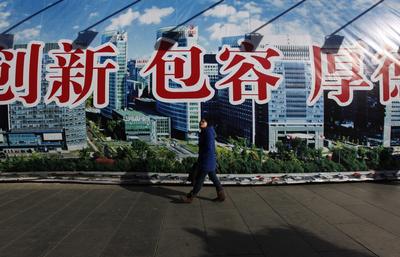The recession in industrial countries also raised political sensitivity, particularly in the United States, to competition from Chinese imports in the face of recession-induced job loss. In China, turning around the structure of growth through structural reform and steady appreciation of the currency became a priority.
Last week, Nick Lardy, from Washington’s Peterson Institute, explained that China suffered from a low share of private consumption expenditure and a super-elevated share of investment in GDP; an outsized manufacturing sector and a diminutive service sector; an unprecedentedly large hoard of official holdings of foreign exchange; and an increasingly high and probably unsustainable rate of investment in residential property. Mitigating these imbalances will require fundamental market-oriented reforms. The pace of reform will need to be accelerated to achieve sustainable, domestically driven growth and harmonious relationships in the international economy, notably with the United States. Lardy saw little sign that there would be early remedy of these structural problems and worried about the tardy pace of reform in China. ‘Market-oriented interest rate liberalisation, eliminating the under-pricing of energy and other factor inputs used predominantly in manufacturing, greater flexibility of the exchange rate and an even more rapid expansion of the social safety net are essential to moving China onto a consumption-driven growth path. Many of these reforms have been on the agenda for a decade or more’, he says, ‘yet with the exception of increased social expenditures, progress has been painfully slow’.
Until recently, all the indicators seemed to suggest that rebalancing China’s economy had not progressed very far at all. A debate is now emerging about whether the signs are being misread.
This week’s lead essay, by Yiping Huang from Peking University and Barclays Capital in Hong Kong, argues that the decline in consumption share may have already turned around. In recent weeks the debate about his hypothesis has heated up.
Huang was an early and active proponent of the view that China needed comprehensive structural reform to remove the distortions in factor and other markets that suppressed consumption and over-stimulated investment and exports. His argument was that both China’s ‘growth miracle’ and its economic imbalances during the country’s reform period were attributable to widespread distortions in factor markets. These distortions generally repress factor costs and effectively subsidise producers, investors and exporters. They also tax households. This explains both the dominance of investment and exports in Chinese growth and weak consumption over the past decade. The key to rebalancing China’s economy, according to Huang, lies in further liberalising its factor markets and removing cost distortions.
There is evidence, Huang now suggests, that ‘the climate for increased consumption has started to improve in recent years’. The changes that have encouraged the boost in the outlook for consumption, he argues interestingly, are more a product of pressures in the market than they are of deliberate policy initiative, although policy reform (particularly in the energy sector and management of the exchange rate regime) have played some role. The most significant changes are rapid growth in wages and the increased role of market-based interest rates. While the People’s Bank of China has not taken concrete steps to liberalise interest rates, lending that is market-based has started to play an increasingly important role in China’s financial intermediation. The lid on financial-market repression, about which Lardy was concerned, is being lifted by the pressures in the domestic capital market itself.
Changes in the Chinese labour and capital markets, Huang says, are having a positive impact on consumption because higher wages and interest income both lift household income and improve income distribution.
Huang suggests official consumption statistics underestimate consumption, which by his reckoning had reversed trend by 2010 and held a 54 per cent share of GDP. Booming retail sales corroborate this evidence of stronger consumption.
These arguments, as Huang says himself, are not without their critics. Some suggest that the household income data Huang uses to adjust consumption data are not reliable. Some argue that retail sales are a poor proxy for consumer demand. And others object to the analysis because China’s undervalued currency, relatively low wage growth and repressed interest rates still show little sign of reversal — and these are crucial factors in repressing household income growth.
Whether China’s declining consumption share is now on the way up and the official statistics underestimate this trend is a question of immense importance. Huang again does an important service in trying to reconcile inconsistencies in the indicators that suggest that the Chinese economy might in fact at last be changing course, not in the straightforward way that some have advocated it must.
Peter Drysdale is Editor of the East Asia Forum.


When you consider a 2008 report of the size and distribution of hidden household income in China estimated that RMB 9.2 trillion of household income is unreported and thus missing from official statistics, then Huang certainly has a valid point when he suggests that consumption is underestimated.
There are some encouraging signs underway if you look at the retail sector – afterall that should be the indicator of domestic consumption.
We’ve reported on a few stories recently which point to this. I particularly noted the comments from Yum’s CEO David Novak (Yum operates KFC and Pizza Hut in China). With wage costs rising at 20 per cent or more, margins were being squeezed. However Novak pointed out that if everyone in their catchments are getting higher wages they would in turn have more disposable income. Like for like sales in stores open for more than two years were growing at 21 per cent. That 21 per cent is a key data point: its the rate at which a defined population – the catchment of a KFC – is expanding its consumption (http://bit.ly/wsEhI0).